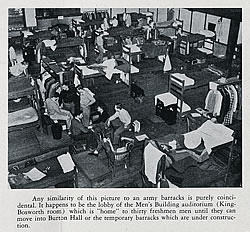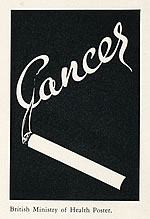 |
 |
 |
||||
 |
|
 |
|
 |
|
A Campus Reacts (1918-1968):
1918 — Just before the close of World War I, an Oberlin unit of the Students’ Army Training Corps is formed, which “brings to the College a spirit of greater sacrifice,” writes the editor. “So as far as the men in Oberlin are concerned, the institution becomes a new West Point. Men in the College will be subject to military discipline. Their time will be controlled by their military obligation.” 1921 — “An Undefeated Team!” screams an OAM headline at the close of football season, a victorious run marked by Oberlin’s 7-6 win over Ohio State. “A long uphill fight ended in Columbus on October 8 when the referee’s whistle blew time and the dazed Ohio State rooters stood in the stands watching the victorious Oberlin squad stream out of the grounds,” write the editors, while also recalling Ohio State’s 128-0 win over Oberlin just five years earlier. OAM emphasizes that the winning season “was notable for the uniformly good sportsmanship and good feeling which dominated every game. It is a matter of pride to stand at the head in any line of achievement, to match strength, brains, character, and teamwork against one’s peers and to pass the test without defeat.” 1933 — Oberlin’s 100th anniversary is celebrated with a six-day alumni reunion: “Seldom has there been such unanimity of sentiment, such united love and loyalty, such conviction of a common cause, as that which overflowed here during the days of the Centennial festivities,” writes OAM. Former Oberlin President Henry Churchill King is awarded the first Alumni Distinguished Service Medal.
1946 — Bulging classrooms and makeshift dorm rooms are par for the course on Oberlin’s crowded postwar campus. “The increasing number of bicycles, the lack of empty seats in chapel, the number of couples at dances, and the fight for seats at football games all reflect the increased campus population,” writes OAM. 1955 — OAM reports that Oberlin ranks fifth among colleges nationwide in producing scientists. 1962 — LIFE magazine includes two alumni in its list of the 100 most important young men and women in the United States: Brad Williams ’51, co-editor and publisher of the Oberlin News-Tribune, which LIFE describes as “one of the more outspoken and courageous small town weeklies,” and Carl Rowan ’47, deputy assistant secretary of state for public affairs and former prize-winning reporter for the Minneapolis Tribune.
1963 — “When news of John F. Kennedy’s assassination reached campus, the bell of Finney Chapel began tolling, tolling for the first time since the assassination of William McKinley in 1901 and for the second time since the assassination of Abraham Lincoln in 1865,” writes OAM. “Those near the chapel entered to sit in silence with tears streaming down their faces.” 1964 — Oberlin’s new Conservatory of Music, designed by Minoru Yamasaki, is dedicated at Homecoming. “Buildings outlast students; they outlast teachers; they outlast instructional methods and theories of education” writes Professor of History Geoffrey Blodgett. “The artists who designed the new Conservatory, the builders who made it, and the donors who have paid for it have given the college a series of buildings that will help it become its best.” 1965 — Martin Luther King, Jr., delivers Oberlin’s 132nd Commencement Address, which is printed in OAM. “I can never come to this campus without a deep sense of appreciation and gratitude for all that this great institution has done for the cultural, political, and social life of our nation and the world,” he states. “By all standards of measurement, Oberlin is one of the great colleges, not only of our nation, but of the world.” 1966 — In announcing the move of the Graduate School of Theology to Vanderbilt University, Dean Harold Fidley writes: “Oberlin will be losing an integral part of her life. But instead of budgetary limitations of 11 faculty members, the new program will have 30 as part of the Vanderbilt Divinity School.” 1968 — A 1967 anti-war demonstration in which 70 students surrounded the car of a U.S. Navy recruiter prompts heated alumni response: “The College backed down on a clear commitment to punish coercive picketing,” and “the riot has caused such an adverse effect to the national image of Oberlin that it will be difficult to interest capable and well-balanced high school students.” Next Page >> |
 1941 — A last-minute insert bears a special message from Alumni Association President Louis Peirce ’28 explaining that the fundraising goals printed in the magazine were finished “before our country was at war.” He continues: “As Oberlin College fulfills its role in the present crisis and in the days ahead, our fundamental objective is to determine how, as alumni, we can help.” A year later, OAM announces Oberlin’s War Program, which allows male students to graduate in just two years—prior to their entrance into military service.
1941 — A last-minute insert bears a special message from Alumni Association President Louis Peirce ’28 explaining that the fundraising goals printed in the magazine were finished “before our country was at war.” He continues: “As Oberlin College fulfills its role in the present crisis and in the days ahead, our fundamental objective is to determine how, as alumni, we can help.” A year later, OAM announces Oberlin’s War Program, which allows male students to graduate in just two years—prior to their entrance into military service.  1963 — Robert Browning ’23, professor of medicine at Ohio State’s College of Medicine, writes a five-page article titled “Cigarettes…What’s the Truth?” which ranks among the early public warnings linking cigarettes to lung cancer. “We should not expect any legislative activity in connection with the use of tobacco,” he predicts. “Even the labeling of packages to indicate the nicotine or tar content will probably fail passage in Congress.”
1963 — Robert Browning ’23, professor of medicine at Ohio State’s College of Medicine, writes a five-page article titled “Cigarettes…What’s the Truth?” which ranks among the early public warnings linking cigarettes to lung cancer. “We should not expect any legislative activity in connection with the use of tobacco,” he predicts. “Even the labeling of packages to indicate the nicotine or tar content will probably fail passage in Congress.”